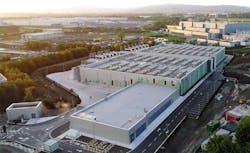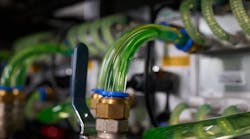Data Center Sustainability: Yesterday, Today, and Tomorrow
But that doesn’t mean we shouldn’t take a beat and consider the progress we have made as an industry, and the innovation that can help deliver significant, measurable results.
For many years, enterprises felt they needed to build, own, and operate data centers on-premises or off-site but as single-tenant facilities. There were many reasons for this. For one, enterprise applications were often custom-built or installed locally on enterprise servers and licensed by the number of servers or processors. Security was a significant concern, and relying on a third party to protect equipment, data, and intellectual property was often a difficult change for enterprises to accept. And until recently major data center providers built their data centers in just a few select markets, requiring customers to come to them.
Outside of the very largest companies in the world, economies of scale could rarely be applied in ways that mitigated the impacts of enterprise data centers on the land, water, air, power supply, and surrounding communities. If that trend had continued unabated, many dire predictions about data center power consumption and greenhouse gas emissions may have been realized.
So, what changed? A lot.
Between 2010 and 2018, data center capacity increased by 600%, internet traffic grew by orders of magnitude, and storage capacity increased by 25x. But data center energy use only grew by 6% over the same period.
As Dr. Jonathan Koomey from Stanford University explains in his June 2021 blog post, the rapid growth in data traffic and transactions does not necessarily cause a corresponding increase in data center energy utilization. Efficiencies introduced into servers, power supplies, cooling, and networking can frequently offset higher processing rates, storage, and traffic. CPUs and GPUs are more powerful and at the same time more efficient. Hyperscale data centers were optimized to reduce PUE levels dramatically in newer, larger facilities built to support the next generation of internet services. Building purpose-built facilities, at scale, in optimal locations, aligned with growing demand in markets worldwide meant enterprises were often disincentivized from building smaller, less efficient premise-based data centers.
Science Magazine, reinforces this point in its 2020 article: data center reliance and utilization keeps rising but new efficiencies tend to more than offset that growth resulting in more effective energy usage.
But that’s not the entire answer. During that same period, awareness, sensitivity, and attention to sustainability entered mainstream business conversations. In addition to capacity numbers and network connectivity, customers made efficiency a criterion for choosing a data center provider. Local municipalities and regulators, at the urging of their communities, asked hard questions as new data centers were proposed and licensed.
And as data center providers grew and expanded globally, they had lots of reasons to build more efficiently, aided by innovations in power generation, water reuse, GHG emissions management, carbon offsets, biodiversity, and more. In turn, elements of sustainability led to a need for transparency and corporate governance because interested parties were suddenly watching to make sure reporting was accurately tracking impacts to the surrounding environment.
As sustainability issues became more prominent in the evaluation and purchasing process, data center providers learned that it’s not enough to tackle just one or two elements of the sustainability story. They know that they will be judged comprehensively, on a complete set of criteria because sustainability is complex, and its effects are inter-connected.
A program that improves cooling in the high altitudes of Santiago may not offer the same benefits in Brussels. And, conversely, water conservation solutions may differ significantly between Dublin and Chennai. Sustainability strategies must take all these factors – and many more – into account if we hope to succeed at meeting our goals.
So, it’s not enough to have good intentions, or to claim progress using anecdotal evidence without neutral, independent confirmation or guidance.
And that’s another area where we see progress today: recognized standards and certifications offer not only guidance but also a common set of metrics so providers can use common terminology and data points, making it easier to track and measure progress industry-wide.
Data center customers are doing their part, as well, making sustainability a component of their purchasing decisions and evaluating supply chains – their own and their suppliers – to make sure compliance extends beyond their own immediate spheres of influence.
As 451 Research noted in a recent report, cloud platform operators are making tools available to help customers calculate their carbon emissions, allowing innovations to be shared and utilized by businesses across many industries in markets around the globe. Sharing these tools helps increase monitoring, tracking, and transparency, and are important precedents for similar steps in areas like water consumption or e-waste management, so customers can compare results with other providers or even with their own on-premise facilities.
At EdgeConneX we are moving on multiple fronts to identify and deliver on both tactical and strategic initiatives across our global footprint. A few examples:
- AdaniConneX, our joint venture in India, is building a nationwide data center platform relying heavily on renewable energy from Adani, the world’s largest supplier to solar power.
- At our Amsterdam campus we deployed a cleansing and conservation solution that reduced our water consumption by 25%.
- EdgeOS, our advanced DCIM platform, allows customers and engineers to perform operational tasks remotely, reducing the need for car and air travel to visit our facilities.
- High-quality Green-E Renewable Energy Certificates (RECs) cover our energy usage across all of our North American data centers.
- We are publishing an annual Sustainability Report, with the next edition available in 2Q 2022 and a commitment to becoming a carbon-, waste-, and water-neutral data center provider powered by 100% renewable energy by 2030.
Finally, while it may be difficult to track direct correlation, it’s important to note that well-placed data centers enable green initiatives in other industries from aviation and healthcare to energy and manufacturing by making IoT, machine learning, cloud, and AI services available both locally and globally.
It’s not all good news, of course. PUE rates are not declining as rapidly as they were five or ten years ago and use cases like legacy enterprise applications or even crypto mining may sometimes operate in older, less efficient data centers undercutting progress in other areas.
But around the world data center companies are committing to and actively working toward firm, transparent sustainability goals and driving innovation and improvements in emissions, water usage, waste reduction, renewable power, efficiency, cooling, biodiversity, and more.
Hard work remains. Sometimes competing data center companies will need to behave more like collaborators, learning which initiatives work best to accelerate sustainable solutions. The key, today and going forward, is a science-based approach that measures progress with transparency and accountability. We have a long way to go, but it’s worth taking a moment once in a while to look around and see how far we’ve already come.
This article was written by Phillip Marangella, CMO of EdgeConneX, a global data center provider focused on driving innovation. Contact EdgeConneX to learn more about their sustainability strategy.


